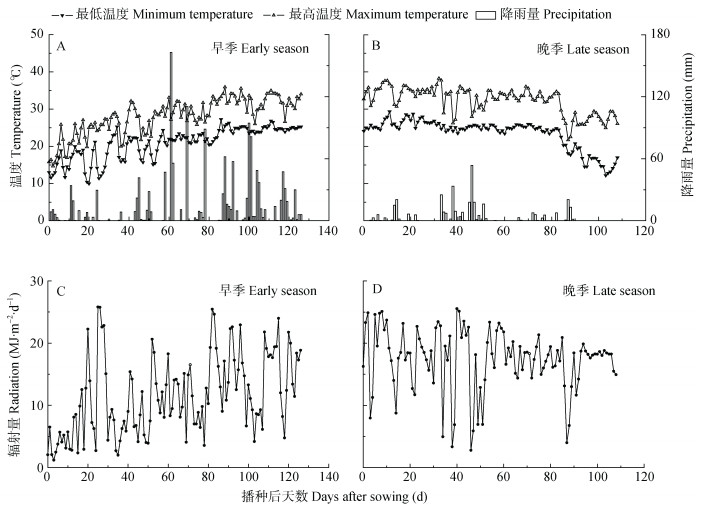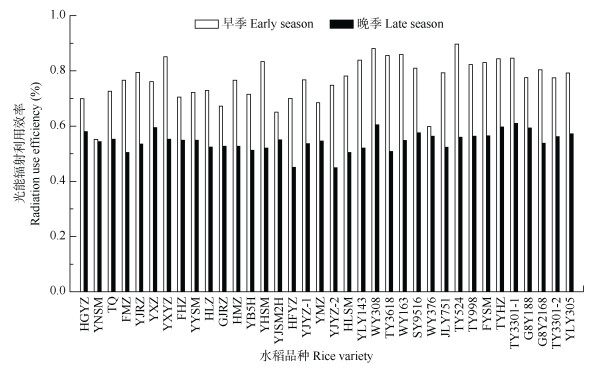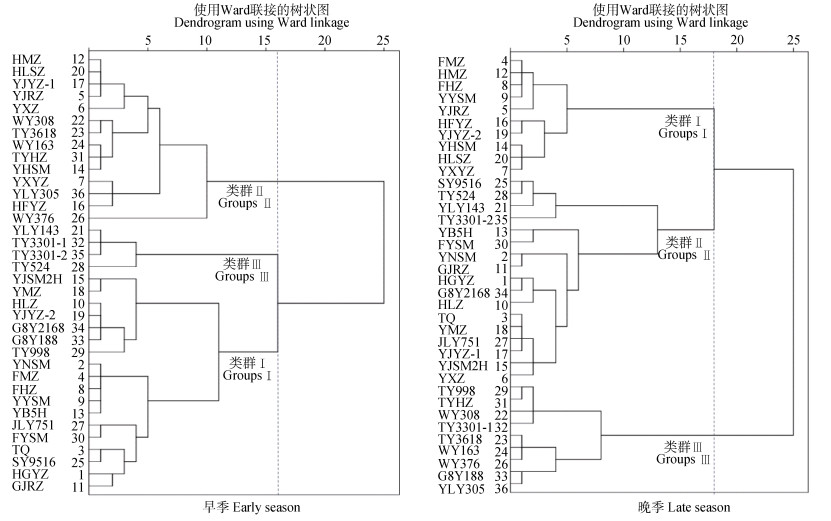Radiation use efficiency and its classification of main varieties in double-cropping rice region of South China
-
摘要: 水稻品种的光能利用效率(RUE)是影响华南双季稻产量的重要因素之一。目前,关于品种的RUE特性及其与农艺性状间关系的研究鲜有报道。为此,本研究以华南双季稻区36个水稻主栽品种为供试材料,探讨了不同品种的RUE及其与产量等主要农艺性状的关系,并进行品种RUE类群的划分。结果表明,水稻的RUE在品种间和季节间的差异均达极显著水平;早、晚季的RUE均与稻谷产量、收获指数及千粒重等呈极显著正相关;早季的RUE与生物量呈极显著正相关、与生育期呈极显著负相关,晚季的则相关不显著。主成分分析结果表明,早季水稻品种特征主要由产量光能效率因子、穗粒因子、生育期粒重因子和结实率因子等4个主成分构成;晚季则主要由产量光能效率因子、穗粒因子、生物量因子、生育期粒重因子和结实率因子等5个主成分构成。通过系统聚类分析将华南双季稻品种划分为低光效型、中光效型和高光效型3个类群。早季低光效型、中光效型和高光效型的品种数分别占供试品种数的50.0%、38.9%和11.1%;晚季的依次分别为27.8%、47.2%和25.0%。其中,‘Y两优143’‘特优524’‘天优3301’和‘特优3301’等4个品种被划分为早季高光效型品种,‘五优308’‘天优3618’‘五优163’‘五优376’‘天优998’‘天优华占’‘天优3301’‘广8优188’和‘Y两优305’9个品种被划分为晚季高光效型品种。本研究结果将对水稻种植区域的品种布局、高RUE品种的选育及其高效利用具有重要指导意义。Abstract: Radiation use efficiency (RUE) of rice varieties is an important factor influencing grain yields of double-cropping rice in South China. However, there have been few studies of rice RUE and its relationship to agronomic traits. We conducted two-season field experiments to evaluate the RUE of 36 major rice varieties in a double-cropping rice region of South China. The relationships between RUE and the main agronomic traits (for example, yield) were explored, and the clustering analysis of tested varieties were classified. The findings revealed highly significant difference of RUE existed in different rice varieties and cropping seasons, respectively. In early and late seasons, RUEs were significantly and positively correlated with the grain yield, the harvest index, and the 1000-grain weight. In the early season, RUE was significantly positively correlated with the biomass and significantly negatively correlated with the growth period; however, in the late season, these correlations were not significant. Principal component analysis revealed the 12 agronomic traits of the tested varieties to be compressed to four independent comprehensive indexes, including the yield and light energy efficiency factor, the panicle and grain number factor, the growth period and grain weight factor, and the seed setting rate factor, in the early season; and to five independent comprehensive indexes, including the yield and light energy efficiency factor, the panicle and grain number factor, the biomass factor, the growth period and grain weight factor, and the seed setting rate factor, in the late season. Clustering analysis revealed that the varieties tested in this study could be divided into three groups:low RUE, medium RUE, and high RUE. Rice varieties numbers with low RUE, medium RUE, and high RUE accounted for 50.0%, 38.9%, and 11.1%, respectively, of the total numbers of tested varieties in the early season and for 27.8%, 47.2%, and 25.0%, respectively of the total numbers in the late season. 'Yliangyou 143' 'Teyou 524' 'Tianyou3301' and 'Teyou3301' were identified as high-RUE varieties in the early season, and 'Wuyou308' 'Tianyou3618' 'Wuyou163' 'Wuyou376' 'Tianyou998' 'Tianyouhuazhan' 'Tianyou3301' 'guang8you188' and 'Yliang you 305' were identified as high-RUE varieties in the late season in South China. In our study, the classification of RUE types for rice varieties has been reported for the first time. The findings will have important guiding significance for the variety layout in growing areas and both the breeding of high-RUE varieties and their efficient utilization.
-
-
表 1 供试品种的名称编号
Table 1 Name and code of rice varieties involved in the experiment
编号
Code品种
VarietyV1 黄广油占
Huangguangyouzhan (HGYZ)V2 粤农丝苗
Yuenongsimiao (YNSM)V3 特青
Teqing (TQ)V4 丰美占
Fengmeizhan (FMZ)V5 银晶软占
Yinjingruanzhan (YJRZ)V6 粤香占
Yuexiangzhan (YXZ)V7 玉香油占
Yuxiangyouzhan (YXYZ)V8 丰华占
Fenghuazhan (FHZ)V9 粤油丝苗
Yueyousimiao (YYSM)V10 黄莉占
Huanglizhan (HLZ)V11 广晶软占
Guangjingruanzhan (GJRZ)V12 合美占
Hemeizhan (HMZ)V13 粤标5号
Yuebiao No. 5 (YB5H)V14 粤禾丝苗
Yuehesimiao (YHSM)V15 粤晶丝苗2号
Yuejingsimiao No. 2 (YJSM2H)V16 合丰油占
Hefengyouzhan (HFYZ)V17 粤金银占
Yuejinyinzhan (YJYZ-1)V18 粤美占
Yuemeizhan (YMZ)V19 粤金油占
Yuejinyouzhan (YJYZ-2)V20 合莉丝占
Helisizhan (HLSZ)V21 Y两优143
Yliangyou 143(YLY143)V22 五优308
Wuyou 308 (WY308)V23 天优3618
Tianyou 3618 (TY3618)V24 五优163
Wuyou 163 (WY163)V25 深优9516
Shenyou 9516 (SY9516)V26 五优376
Wuyou 376 (WY376)V27 聚两优751
Juliangyou 751 (JLY751)V28 特优524
Teyou 524 (TY524)V29 天优998
Tianyou 998 (TY998)V30 丰优丝苗
Fengyousimiao (FYSM)V31 天优华占
Tianyouhuazhan (TYHZ)V32 天优3301
Tianyou 3301 (TY3301-1)V33 广8优188
Guang8you 188 (G8Y188)V34 广8优2168
Guang8you 2168 (G8Y2168)V35 特优3301
Teyou 3301 (TY3301-2)V36 Y两优305
Yliangyou 305 (YLY305)表 2 36个供试水稻品种早晚季12个农艺性状的表现
Table 2 Performance of 12 agronomic traits for 36 rice varieties in early and late seasons
性状
Trait早季稻Early season rice 晚季稻Late season rice 早、晚季差值
D-value (%)平均
Mean标准差
SD最大值
Max最小值
MinF值
F-value平均
Mean标准差
SD最大值
Max最小值
MinF值
F-valueGD (d) 126.29 2.50 132.00 125.00 4.23** 112.33 3.14 116.00 108.00 0.78 12.42 GYH (t·hm-2) 7.51 0.75 9.33 5.28 6.60** 6.94 0.63 8.69 5.03 2.05** 8.25 GYDH (t·hm-2·d-1) 59.49 5.94 72.93 42.25 6.10** 61.73 5.47 74.91 43.39 2.35** -3.62 BH (t·hm-2) 15.67 1.45 18.81 10.08 4.82** 15.10 1.08 18.15 12.42 1.13 3.81 BDH (t·hm-2·d-1) 124.04 11.25 147.35 80.64 4.01** 134.37 10.40 163.47 107.03 0.94 -7.69 EPSM (panicles·m-2) 256.01 35.75 363.08 166.15 3.47** 257.98 32.33 363.08 184.62 3.47** -0.76 SP 168.43 23.98 240.26 110.79 6.86** 156.07 15.94 200.32 114.70 4.84** 7.92 FSP 124.30 18.17 183.83 85.25 5.73** 130.78 16.23 179.08 94.90 4.94** -4.95 TGW (g) 23.88 2.78 31.91 19.62 85.06** 23.59 2.94 31.29 18.47 158.10** 1.25 SSR (%) 74.03 5.91 88.75 57.93 2.11** 83.76 5.21 93.58 66.93 3.40** -11.62 HI 0.48 0.04 0.59 0.39 8.14** 0.52 0.03 0.60 0.43 5.55** -7.38 RUE (%) 0.774 0.079 0.897 0.552 5.65** 0.543 0.048 0.610 0.449 2.27** 42.55 **表示差异达极显著(1%)水平。GD:生育期; GYH:稻谷产量; GYDH:日产量; BH:生物量; BDH:日均生物量; EPSM:有效穗数; SP:穗粒数; FSP:每穗实粒数; TGW:千粒重; SSR:结实率; HI:收获指数; RUE:光能利用效率。** means significance at 1% level. GD: growth duration; GYH: grain yield per hectare; GYDH: grain yield per day per hectare; BH: biomass per hectare; BDH: biomass per day per hectare; EPSM: effective panicles per square meter; SP: spikelets per panicle; FSP: filled spikelets per panicle; TGW: 1 000-grain weight; SSR: seed setting rate; HI: harvest index; RUE: radiation utilization efficiency. D-value: difference value between the two seasons. 表 3 水稻主要农艺性状在早、晚季中的特征向量值及贡献率
Table 3 Eigenvectors and contribution rates of main agronomic traits of rice in early and late seasons
性状
Trait早季稻zEarly season rice 晚季稻Late season rice 主成分1
Component 1主成分2
Component 2主成分3
Component 3主成分4
Component 4主成分1
Component 1主成分2
Component 2主成分3
Component 3主成分4
Component 4主成分5
Component 5GD -0.081 0.071 0.872 -0.048 -0.025 -0.038 -0.099 0.189 -0.129 GYH 0.974 0.073 0.155 0.016 0.931 -0.002 -0.053 0.122 -0.113 GYDH 0.992 0.059 -0.010 0.025 0.943 0.026 0.012 -0.012 -0.078 BH 0.525 -0.053 0.272 0.015 -0.030 0.003 0.993 -0.076 0.073 BDH 0.563 -0.072 0.077 0.029 -0.031 0.003 0.992 -0.076 0.076 EPSM -0.064 -0.838 -0.292 -0.091 0.013 -0.223 0.103 -0.883 -0.252 SP 0.117 0.741 -0.190 -0.302 -0.015 0.964 -0.017 0.039 0.074 FSP 0.118 0.778 -0.230 0.167 -0.117 0.863 0.056 0.012 0.482 TGW 0.460 -0.097 0.667 -0.045 0.233 -0.144 -0.084 0.861 -0.379 SSR -0.018 0.045 -0.074 0.995 -0.227 0.136 0.143 -0.027 0.885 HI 0.576 0.148 -0.106 -0.040 0.284 0.701 -0.028 0.062 -0.322 RUE 0.922 0.102 -0.099 -0.095 0.933 0.009 -0.040 0.115 -0.108 E 5.249 3.316 1.472 1.210 4.141 2.527 2.245 1.472 0.923 CR 40.37 25.51 11.32 9.31 31.85 19.44 17.27 11.32 7.10 TCR 40.37 65.88 77.20 86.51 31.85 51.29 68.55 79.87 86.97 GD:生育期; GYH:稻谷产量; GYDH:日产量; BH:生物量; BDH:日均生物量; EPSM:有效穗数; SP:穗粒数; FSP:每穗实粒数; TGW:千粒重; SSR:结实率; HI:收获指数; RUE:光能利用效率; E:特征值; CR:贡献率; TCR:累计贡献率。GD: growth duration; GYH: grain yield per hectare; GYDH: grain yield per day per hectare; BH: biomass per hectare; BDH: biomass per day per hectare; EPSM: effective panicles per square meter; SP: grians per panicle; FSP: filled spikelets per panicle; TGW: 1 000-grain weight; SSR: seed setting rate; HI: harvest index; RUE: radiation utilization efficiency, E: eigen value; CR: contribution rate; TCR: total contribution rate. 表 4 不同水稻品种类群的主要农艺性状均值
Table 4 Average values of main agronomic traits of the tested rice varieties of different groups
季别
Season类群
Group生育期
Growth duration (d)生物量
Biomass (t·hm-2)产量
Grain yield (t·hm-2)收获指数
Harvest index千粒重
1000-grain weight (g)结实率
Seed setting rate (%)穗粒数
Grains per panicle有效穗数
Effective panicles (panicles·m-2)光能利用效率
Radiation utilization efficiency (%)早季
Early seasonⅠ 126.3 15.84 7.23 0.457 23.91 72.85 157.0 264.6 0.734 Ⅱ 125.6 15.05 7.61 0.507 22.33 75.10 186.4 253.0 0.792 Ⅲ 128.8 17.26 8.44 0.491 29.87 74.89 159.4 231.3 0.839 全部Total 126.3 15.67 7.50 0.480 23.88 74.03 168.4 256.0 0.772 晚季
Late seasonⅠ 111.9 14.96 6.56 0.505 20.79 86.78 161.2 262.2 0.514 Ⅱ 112.7 14.97 7.01 0.505 24.56 83.13 146.4 257.4 0.547 Ⅲ 111.9 15.44 7.32 0.558 24.41 82.41 167.6 257.0 0.573 全部Total 112.4 15.08 6.94 0.518 23.59 83.71 156.1 257.9 0.542 类群Ⅰ、Ⅱ和Ⅲ分别为低光效、中光效和高光效类群。Group Ⅰ, Ⅱ and Ⅲ are rice varieties groups with low, medium and high radiation utilization efficiency, respectively. 表 5 各类群水稻品种的RUE与主要农艺性状间的相关系数
Table 5 Correlation coefficients between radiation utilization efficiency (RUE) and main agronomic traits of rice varieties in different groups
季别
Season类群
Group生育期
Total duration生物量
Biomass稻谷产量
Grain yield收获指数
Harvest index千粒重
1 000-grain weight结实率
Seed setting rate总粒数
Spikelets per panicle有效穗数
Effective panicles早季
Early seasonⅠ -0.543 5** 0.563 8** 0.931 2** 0.529 7** 0.447 1** -0.161 6 0.068 2 0.049 1 Ⅱ -0.209 0 0.757 0 0.972 5** 0.234 3 0.327 6 0.187 0 -0.127 0 0.071 6 Ⅲ -0.512 4 0.520 7 0.871 2** 0.573 6* -0.021 5 0.218 8 -0.195 0 -0.284 0 全部Total -0.268 3** 0.584 2** 0.941 6** 0.464 9** 0.339 9** 0.097 6 0.088 8 -0.083 5 晚季
Late seasonⅠ -0.357 1* -0.118 3 0.985 3** 0.420 5* -0.176 5 0.268 0 -0.034 3 0.107 6 Ⅱ 0.402 0** 0.159 6 0.980 6** 0.119 4 0.076 6 -0.032 6 0.118 8 0.021 4 Ⅲ 0.113 4 0.215 9 0.986 5** -0.221 7 0.181 8 -0.138 9 0.018 7 0.032 7 全部Total 0.061 2 0.154 2 0.985 0** 0.281 1** 0.252 4** -0.136 3 0.050 1 0.015 6 类群Ⅰ、Ⅱ和Ⅲ分别为低光效、中光效和高光效类群。**和*分别表示在0.01和0.05水平下显著相关。Group Ⅰ, Ⅱ and Ⅲ are rice varieties groups with low, medium and high radiation utilization efficiency, respectively. ** and * mean significant correlation at 0.01 and 0.05 levels, respectively. -
[1] 薛德榕.水稻光能利用与高产潜力[J].广东农业科学, 1977, (3): 27-28 http://www.cnki.com.cn/Article/CJFDTotal-GDNY197703012.htm XUE D R. Radiation use efficiency and high yield potential of rice[J]. Journal of Guangdong Agricultural Sciences, 1977, (3): 27-28 http://www.cnki.com.cn/Article/CJFDTotal-GDNY197703012.htm
[2] 吕军, 俞劲炎, 张连佳.低丘红壤地区粮食作物光能利用率和农田能流分析[J].生态学杂志, 1990, 9(8): 11-15 http://www.cnki.com.cn/Article/CJFDTotal-STXZ199006002.htm LYU J, YU J Y, ZHANG L J. Photo-utilization efficiency of grain crop and field energy-flow analysis in low-hilly red soil region[J]. Chinese Journal of Ecology, 1990, 9(8): 11-15 http://www.cnki.com.cn/Article/CJFDTotal-STXZ199006002.htm
[3] MONTEITH J L, MOSS C J. Climate and the efficiency of crop production in Britain[J]. Philosophlical Transactions of the Royal Society B: Biological Sciences, 1977, 281(980): 277-294 http://www.wanfangdata.com.cn/details/detail.do?_type=perio&id=10.1177/027046769901900603
[4] 戚昌翰, 石庆华.江西的太阳辐射资源与水稻生产潜力[J].江西农业大学学报, 1987, (S1): 15-17 http://www.cnki.com.cn/Article/CJFDTotal-JXNK198104010.htm QI C H, SHI Q H. Solar radiation resources and potential for rice production of Jiangxi Province[J]. Acta Agriculturae Universitatis Jiangxiensis, 1987, (S1): 15-17 http://www.cnki.com.cn/Article/CJFDTotal-JXNK198104010.htm
[5] 张旭.水稻生态育种[M].北京:中国农业出版社, 1991: 131-132 ZHANG X. Ecological breeding of rice[M]. Beijing: China Agricultural Press, 1991: 131-132
[6] 陈友订, 黄秋妹, 黄农荣.几个两系法高产杂交组合的光能利用率初探[J].杂交水稻, 2000, 15(5): 37-40 http://d.old.wanfangdata.com.cn/Periodical/zjsd200005018 CHEN Y D, HUANG Q M, HUANG N R. Preliminary studies on utilization ratio of solar energy for several high-yielding two-line hybrid rice combinations[J]. Hybrid Rice, 2000, 15(5): 37-40 http://d.old.wanfangdata.com.cn/Periodical/zjsd200005018
[7] 李迪秦, 唐启源, 秦建权, 等.水稻光能辐射利用率与产量的关系[J].湖南农业大学学报:自然科学版, 2011, 37(1): 1-6 http://d.old.wanfangdata.com.cn/Periodical/hunannydx201101001 LI D Q, TANG Q Y, QIN J Q, et al. Relationship between solar radiation use efficiency and rice grain yield[J]. Journal of Hunan Agricultural University: Natural Sciences, 2011, 37(1): 1-6 http://d.old.wanfangdata.com.cn/Periodical/hunannydx201101001
[8] ZHANG Y B, TANG Q Y, ZOU Y B, et al. Yield potential and radiation use efficiency of "super" hybrid rice grown under subtropical conditions[J]. Field Crops Research, 2009, 114(1): 91-98 http://www.wanfangdata.com.cn/details/detail.do?_type=perio&id=d93a2e2d186638d6071acf07e1995e5b
[9] 吕凤, 杨帆, 范滔, 等. 1977—2018年水稻品种审定数据分析[J].中国种业, 2019, (2): 29-40 http://www.cnki.com.cn/Article/CJFDTotal-ZWPZ201902010.htm LYU F, YANG F, FAN T, et al. Data analysis for approved rice varieties during 1977-2018[J]. China Seed Industry, 2019, (2): 29-40 http://www.cnki.com.cn/Article/CJFDTotal-ZWPZ201902010.htm
[10] 黄湛.广东水稻的增产潜力[J].华南农业大学学报, 1996, 17(4): 46-51 http://www.wanfangdata.com.cn/details/detail.do?_type=perio&id=QK199600235235 HUANG Z. Yield potential of rice in Guangdong[J]. Journal of South China Agricultural University, 1996, 17(4): 46-51 http://www.wanfangdata.com.cn/details/detail.do?_type=perio&id=QK199600235235
[11] 周继勇, 林绿, 刘夏平, 等. '湘两优900'在华南作双季超级稻高产攻关中的种植表现及高产栽培技术[J].杂交水稻, 2017, 32(6): 34-36 http://d.old.wanfangdata.com.cn/Periodical/zjsd201706011 ZHOU J Y, LIN L, LIU X P, et al. Performance and high-yielding cultural techniques of 'Xiangliangyou 900' grown as double-cropping super rice in South China[J]. Hybrid Rice, 2017, 32(6): 34-36 http://d.old.wanfangdata.com.cn/Periodical/zjsd201706011
[12] 中国农业年鉴编辑委员会.中国农业年鉴1996[M].北京:中国农业出版社, 1996: 292-296 Editorial Committee of China Agricultural Yearbook. China Agricultural Yearbook 1996[M]. Beijing: China Agricultural Press, 1996: 292-296
[13] 中国农业年鉴编辑委员会.中国农业年鉴2017[M].北京:中国农业出版社, 2017: 293-297 Editorial Committee of China Agricultural Yearbook. China Agricultural Yearbook 2017[M]. Beijing: China Agricultural Press, 2017: 293-297
[14] 钟旭华, 黄农荣, 郑海波, 等.水稻"三控"施肥技术规程[J].广东农业科学, 2007, (5): 13-15 http://www.wanfangdata.com.cn/details/detail.do?_type=perio&id=gdnykx200705003 ZHONG X H, HUANG N R, ZHENG H B, et al. Specification for the "Three Controls" nutrient management technology for irrigated rice[J]. Guangdong Agricultural Sciences, 2007, (5): 13-15 http://www.wanfangdata.com.cn/details/detail.do?_type=perio&id=gdnykx200705003
[15] 农业技术经济手册编委会.农业技术经济手册[M].北京:中国农业出版社, 1983: 815-824 《Technical and Economic Agricultural Manual》editorial board. Technical and Economic Agricultural Manual[M]. Beijing: China Agricultural Press, 1983: 815-824
[16] KINIRY R J, MCCAULEY G, XIE Y, et al. Rice parameters describing crop performance of four U.S. cultivars[J]. Agronomy Journal, 2001, 93(6): 1354-1361
[17] YAMAMOTO H, LWAYA K, TAKASU Y. Comparisons of efficiency of solar energy utilization and efficiency of solar energy conversion in high-yielding rice canopies[J]. Journal of Agricultural Meteorology, 2003, 59(1): 1-11 http://cn.bing.com/academic/profile?id=4919136068771bc06c6faba2b60cc359&encoded=0&v=paper_preview&mkt=zh-cn
[18] 谢光辉, 苏宝林, 石磊, 等.湘西武陵山区单季稻生长发育及物质生产的研究: Ⅱ.不同海拔播期对杂交稻物质生产的影响[J].中国农业大学学报, 1996, 1(1): 89-94 XIE G H, SU B L, SHI L, et al. A Study on growth and dry matter production of rice in Wuling Mountain area: Ⅱ. Effects of sowing date on dry matter production of hybrid rice[J]. Journal of China Agricultural University, 1996, 1(1): 89-94
[19] 王建林, 徐正进.穗型和行距对水稻冠层受光态势的影响[J].中国水稻科学, 2005, 19(5): 422-426 http://d.old.wanfangdata.com.cn/Periodical/zgsdkx200505007 WANG J L, XU Z J. Effects of panicle type and row spacing on light distribution of rice canopy[J]. Chinese Journal of Rice Science, 2005, 19(5): 422-426 http://d.old.wanfangdata.com.cn/Periodical/zgsdkx200505007
[20] 冯永祥, 徐正进, 姚占军.行向对不同穗型水稻群体微气象特性影响的研究——Ⅰ行向对群体内太阳直接辐射影响的理论分析[J].中国农业气象, 2002, 23(3): 18-21 http://d.old.wanfangdata.com.cn/Periodical/zgnyqx200203005 FENG Y X, XU Z J, YAO Z J. Studies on effects of micrometeorological characters of row directions in rice populations with different panicle types — Ⅰ. theoretical analyses of effects of row directions on immediate radiation of sun in the rice populations[J]. Agricultural Meteorology, 2002, 23(3): 18-21 http://d.old.wanfangdata.com.cn/Periodical/zgnyqx200203005
[21] 邹应斌, 周上游, 唐启源.中国超级杂交水稻超高产栽培研究的现状与展望[J].中国农业科技导报, 2003, 5(1): 31-35 http://d.old.wanfangdata.com.cn/Periodical/zgnykjdb200301007 ZOU Y B, ZHOU S Y, TANG Q Y. Status and outlook of high yielding cultivation researches on China super hybrid rice[J]. Review of China Agricultural Science and Technology, 2003, 5(J): 31-35 http://d.old.wanfangdata.com.cn/Periodical/zgnykjdb200301007
[22] 杨建昌, 陈忠辉, 杜永.水稻超高产群体特征及其栽培技术[J].中国农业科技导报, 2004, 6(4): 37-41 http://d.old.wanfangdata.com.cn/Periodical/zgnykjdb200404007 YANG J C, CHEN Z H, DU Y. Characteristics of super high-yielding population of rice and cultivation techniques[J]. Review of China Agricultural Science and Technology, 2004, 6(4): 37-41 http://d.old.wanfangdata.com.cn/Periodical/zgnykjdb200404007
[23] CHEN W F, XU Z J, ZHANG L B, et al. Effects of different panicle type on canopy properties light distribution and dry matter production of rice population[J]. Acta Agronomica Sinica, 1995, 21(1): 83-89
[24] 吕川根, 邹江石.两个超级杂交稻与汕优63光合株型的比较分析[J].中国农业科学, 2003, 36(6): 633-639 http://d.old.wanfangdata.com.cn/Periodical/zgnykx200306006 LYU C G, ZOU J S. Comparative analysis on plant type of two super hybrid rice and Shanyou 63[J]. Scientia Agricultura Sinica, 2003, 36(6): 633-639 http://d.old.wanfangdata.com.cn/Periodical/zgnykx200306006
[25] 康文启, 欧阳由男, 章善庆, 等.分蘖角度动态型水稻的形态特征及生长特性分析[J].中国水稻科学, 2007, 21(4): 372-378 http://d.old.wanfangdata.com.cn/Periodical/zgsdkx200704008 KANG W Q, OUYANG Y N, ZHANG S Q, et al. Morphological and ontogenic characterization of rice with dynamic tiller angle[J]. Chinese Journal of Rice Science, 2007, 21(4): 372-378 http://d.old.wanfangdata.com.cn/Periodical/zgsdkx200704008
[26] 刘忠祥, 寇思荣, 何海军, 等. 155份玉米自交系的类群鉴定和主成分分析[J].河南农业科学, 2012, 41(6): 19-23 http://d.old.wanfangdata.com.cn/Periodical/hnnykx201206004 LIU Z X, KOU S R, HE H J, et al. Principal component analysis and group identification of 155 maize inbred lines[J]. Journal of Henan Agricultural Sciences, 2012, 41(6): 19-23 http://d.old.wanfangdata.com.cn/Periodical/hnnykx201206004
[27] 游书梅, 曹应江, 郑家奎, 等. 73份亚洲水稻恢复系农艺性状的主成分与聚类分析[J].植物遗传资源学报, 2015, 16(2): 250-256 http://d.old.wanfangdata.com.cn/Periodical/zwyczyxb201502006 YOU S M, CAO Y J, ZHENG J K, et al. Principal component and cluster analysis for agronomic traits of 73 rice restorers lines in Asia[J]. Journal of Plant Genetic Resources, 2015, 16(2): 250-256 http://d.old.wanfangdata.com.cn/Periodical/zwyczyxb201502006
[28] 李春花, 王艳青, 卢文洁, 等.云南薏苡种质资源农艺性状的主成分和聚类分析[J].植物遗传资源学报, 2015, 16(2): 277-281 http://d.old.wanfangdata.com.cn/Periodical/zwyczyxb201502010 LI C H, WANG Y Q, LU W J, et al. The principal component and cluster analysis of agronomic traits of coix fermplasm resources in Yunnan[J]. Journal of Plant Genetic Resources, 2015, 16(2): 277-281 http://d.old.wanfangdata.com.cn/Periodical/zwyczyxb201502010
[29] 吴海燕, 金荣德, 范作伟, 等.基于主成分和聚类分析的黑土肥力质量评价[J].植物营养与肥料学报, 2018, 24(2): 325-334 http://d.old.wanfangdata.com.cn/Periodical/zwyyyflxb201802005 WU H Y, JIN R D, FAN Z W, et al. Assessment of fertility quality of black soil based on principal component and cluster analysis[J]. Journal of Plant Nutrition and Fertilizers, 2018, 24(2): 325-334 http://d.old.wanfangdata.com.cn/Periodical/zwyyyflxb201802005
[30] 陈洪凡, 兰波, 梁玉勇, 等.应用主成分分析法评价稻田生态系统稳定性[J].应用昆虫学报, 2017, 54(5): 876-884 http://d.old.wanfangdata.com.cn/Periodical/kczs201705021 CHEN H F, LAN B, LIANG Y Y, et al. Application of principal component analysis to evaluation of the stability of rice paddy ecosystems[J]. Chinese Journal of Applied Entomology, 2017, 54(5): 876-884 http://d.old.wanfangdata.com.cn/Periodical/kczs201705021
[31] 崔静宇, 关小康, 杨明达, 等.基于主成分分析的玉米萌发期抗旱性综合评定[J/OL].玉米科学, (2018-10-26).https://www.cnki.net/KCMS/detail/22.1201.S.20181024.1344.004.html CUI J Y, GUAN X K, YANG M D, et al. Integrative evaluation of maize drought tolerance in germination period by PCA method[J/OL]. Journal of Maize Sciences (Network Start), (2018-10-26). https://www.cnki.net/KCMS/detail/22.1201.S.20181024.1344.004.html
[32] 袁东升, 王晓敏, 赵宇飞, 等. 100份番茄种质资源表型性状的遗传多样性分析[J].西北农业学报, 2019, 28(4): 594-601 http://d.old.wanfangdata.com.cn/Periodical/xbnyxb201904012 YUAN D S, WANG X M, ZHAO Y F, et al. Genetic diversity analysis of 100 tomato germplasm resources based on phenotypic traits[J]. Acta Agriculturae Boreali-occidentalis Sinica, 2019, 28(4): 594-601 http://d.old.wanfangdata.com.cn/Periodical/xbnyxb201904012
[33] 浙江农业大学.实用水稻栽培学[M].上海:上海科学技术出版社, 1981: 122-162 Zhejiang Agricultural University. Practical Rice Cultivation[M]. Shanghai: Shanghai Science and Technology Press, 1981: 122-162




 下载:
下载:


